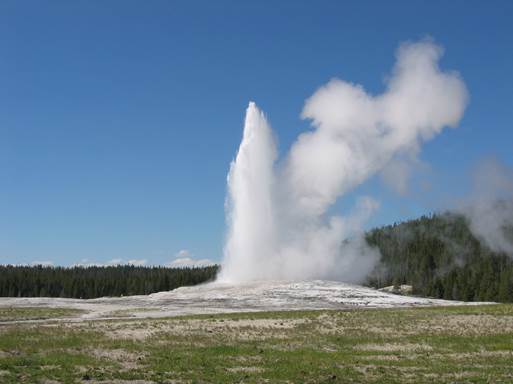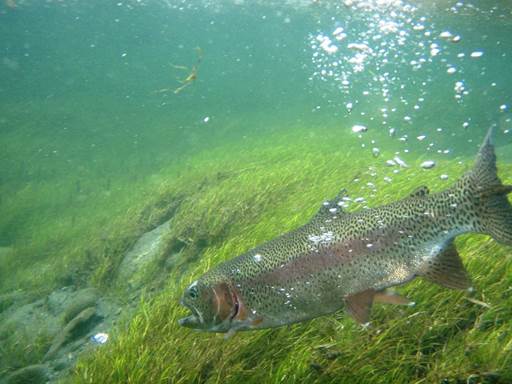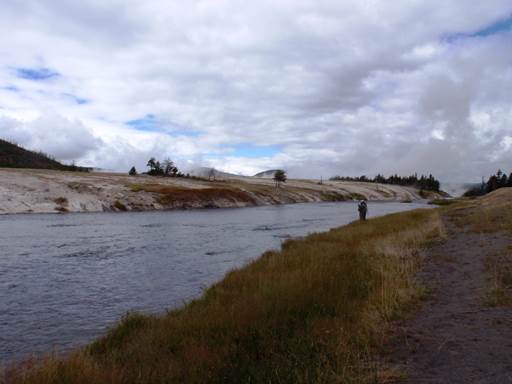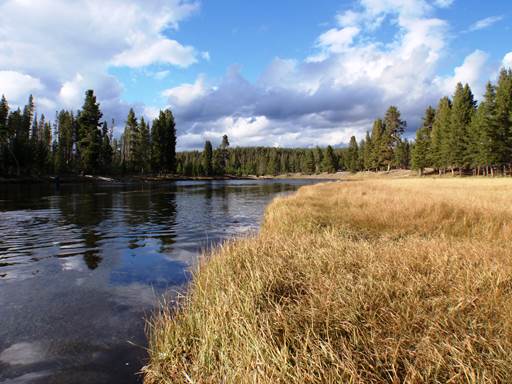THE FLY FISHING CHRONICLES OF YELLOWSTONE NATIONAL PARK – PART5
| Sysadmin Note |
|---|
| Part 4 can be found here |
The Firehole River is one of the most storied of the rivers contained within the boundaries of Yellowstone National Park. Many notable angling authors have shared their stories of time spent on the Firehole, Ray Bergman, Charlie Brooks, Ernest Schwiebert and Rene Harrop are but a few of those who have regaled us with the mysteries of this hauntingly beautiful river.

The early trappers named the river for the steam that makes it appear that the river is smoking as if it were on fire and thus the river was called the Firehole. Madison Lake lies at 8,200 feet on the north facing slopes of the continental divide and is the source for the Firehole River. As the river travels on its journey to join the Gibbon River and forms the Madison River it run through some pretty spectacular country which includes Old Faithful Geyser Basin and the single most famous geyser found in Yellowstone Park. It also travels through Kepler Cascades, the Upper Geyser Basin, Midway Geyser Basin, and found along its banks are Morning Glory Pool, Excelsior Springs and Ojo Caliente Springs and the Falls of the Firehole. So even if you encounter a day when the trout are being less that agreeable you will still be fishing in some of the most beautiful country in the world.
During the course of its journey from Madison Lake to Junction Pool where it joins the Gibbon the Firehole has several tributaries that enter and add to the flows; they are Sentinel Creek, Fairy Creek, Iron Spring Creek, the Little Firehole River and Nez Perce Creek. In the early years of discovery the Firehole River was devoid of fish above the falls just above Junction Pool.
Brook Trout were introduced above the falls in 1889, they soon move to the water above Old Faithful Geyser and all the way up to Madison Lake. In 1890 the Brown Trout were introduced and soon begin to thrive in the waters of the river.

The Rainbow Trout were introduced in 1923.As was common at the time, the U.S. Fish and Wildlife Service continued to stock the water of the park until 1955 when all stocking ceased. While the trout that the anglers catch today are totally wild many studies have been conducted to figure out how these trout survive in water temperatures of the Firehole River which is considerably warmer at certain times of the year than trout are suppose to be able to tolerate.
On August 17th 1959 at 11:37 P.M. an earthquake measuring 7.6 on the Richter scale struck the Hebgen Lake and the Madison River creating Quake Lake. Aftershocks of 5.8 to 6.3 continued to rock the area including the geothermal areas of Yellowstone Park. The geysers, hot springs and mud pots along the Firehole River went wacky and it was six months to a year before the Firehole settled back into a normal routine. During this time period the water temperature in the river rose and the water turned color as the unusual activity caused by the earthquake pumped a whole lot of different chemicals into the river. These changes in turn resulted in some fish kills. However the river and the trout have both rebounded from this natural event and today it holds good populations of Brown and Rainbows.

I began to fish the Firehole River in 1976 and over the years I have enjoyed many adventures on the river and I have learned that the river that smokes is one of the most challenging rivers that the angler will ever fish and at the same time it is one of the most exciting river that the angler will ever fish. Being new to the area, I was soon to meet such notable anglers like Bob Jacklin, Bud Lilley, Charlie Brooks, Craig Mathews, and Sylvester Nemes all of whom would have an impact on my career and broaden my knowledge base.
The Firehole from Old Faithful Geyser downstream is a rich river, as far as hatches and aquatic food forms are concerned, therefore the angler can encounter both standard hatches as well as complex hatches. The river has thick and heavy weedbeds, riffles; deep smooth flowing runs and flats. Basically it appears to be a very rich spring creek and is often classed as such.

The section from the upper geyser basin to past the Nez Pearce Picnic area is the most heavily fished area of the river, the section above Old Faithful to the source is a typical high plateau woodland stream with brook trout and pan sized brown trout to be fished for. The differences between the upper river and the section that runs through the geyser basin are startling as are the difference between the water below the falls and that of the middle section of the river; it is like having three difference rivers to choose from. Most choose the middle section, however both the upper and lower sections of the river have anglers who wish to challenges these waters and learn the secrets of the water.
Because of the constraints of time I primarily fished the Firehole on the traditional Memorial Day Opener and the month that follows and again during the fall of the year starting around September 15th to the end of the season, which now is the first Sunday in November but in the old days it was October 31st. I am often asked, "Is the Firehole River a big fish fishery?" The answer is NO, however the river does hold some large trout. Many of the trout will run 8 to 12 inches with 12 to 15 inches not uncommon. Larger trout of 15 inches plus are fewer in numbers, yet the Firehole still holds some true trophies of 3½ to 5½ pounds that on occasion fall prey to the angler's fly. I will tell you that my favorite time on the Firehole is in the fall. There is something about the beauty of the river, the plumes of geyser steam and the crispness of the air on a fall day that restores my soul and brings me peace. The Firehole River should be on every angler's "Bucket List".
Enjoy & Good Fishin'
HIGHLIGHTS OF THE HATCHES FOUND ON THE FIREHOLE RIVER
IN YELLOWSTONE NATIONAL PARK
Due to the effects of the thermal features on the water temperature, I choose only to fish the Firehole from opening day (approximately May 28) to July 1 and then again in the fall from September 15 to closing (the first Sunday in November.) Therefore, the information contained on this hatch chart deals with these time periods. The emergence dates may vary from year to year due to weather conditions. Also the hatch chart is centered on the middle section of the river.
MAYFLIES |
|
SIZE |
AVAILABILITY DATES |
|---|---|---|---|
Western Blue Quill |
Rhitrogena |
14-16 |
June 1-June 30 |
Pale Morning Duns |
Ephemerella inermis |
14-20 |
May 31-July 1 |
Blue Winged Olives |
Baetis parvus |
16-20 |
May 28-June 15 |
Small Western Green Drakes |
E. flavinea |
12-16 |
June 1-June 30 |
Fall Blue Winged Olives |
Baetis tricaudatus |
18-20 |
Sept. 15-Oct. 31 |
Tiny Western Olives |
P. edmundis |
18-24 |
Sept. 15-Oct. 31 |
|
|
|
|
|
|
|
|
CADDIS |
|||
Little Tan Caddis |
Glossosoma |
14-20 |
May 28-June 30 |
Grannom |
B. occidentalis |
12-16 |
June 5-July 1 |
Brown Caddis |
Brachycentrus |
14-16 |
May 288-June 20 |
Little Spotted Sedge |
Hydropsyche |
16-20 |
Sept. 15-Oct. 15 |
Little Dark Micro Caddis |
|
18-22 |
Sept. 20-Oct. 20 |
|
|
|
|
|
|
|
|
STONEFLIES |
|||
Little Olive Stone |
Alloperla |
14-18 |
June 10-July 1 |
Little Yellow Stone |
Isoperla |
14-18 |
June 5-July 1 |
|
|
|
|
|
|
|
|
TERRESTRIALS |
|||
Black Ants |
|
14-22 |
June 10-July 1 |
Black Beetles |
|
12-20 |
June 5-July 1 |
Flying Black Ants |
|
16-22 |
Sept. 15-Oct. 10 |
|
|
|
|
|
|
|
|
MIDGES |
|||
Spring Midges |
|
16-20 |
May 28-June 15 |
Fall Midges |
|
18-26 |
Sept. 15-Oct. 31 |
|
|
|
|
|
|
|
|
NYMPHS/AQUATICS |
|||
Pale Olive Damsel Nymph |
|
12-14 |
May 28-July 1 |
Brown Damsel Nymph |
|
12-14 |
May 28-July 1 |
Dk. Brown/Olive Dragon Nymph. |
|
6-10 |
May 28-July 1 |
Grey Crane Fly Larva |
|
6-10 |
May 28-July 1 |
Olive/Brown Leeches |
|
8-12 |
All Season |
Black Leeches |
|
8-12 |
All Season |
Assorted Minnows |
|
6-12 |
All Season |
| Sysadmin Note |
|---|
| Part 6 can be found here |
